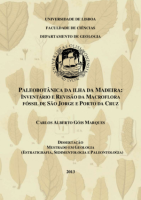Paleobotany of Madeira

After more than 150 years of paleobotanical investigations interregnum in Madeira Island, this dissertation aims to revive and present the history, location, inventory and review of the S. Jorge (SJ) and Porto da Cruz (PC) macroflora.
Historically, Lyell and Hartung discovered on January 18, 1854 in SJ, a leaf-bed full of laurels and fern fossils. The results of this discovery were published in two papers, one by Heer (1857) and another by Bunbury (1859). The specimens of these publications are currently housed in the ETH-Z-DERDW, and NHM-UK and SMC, respectively; a third collection gathered by Hartung is currently missing.
In 1859, Johnson discovers the deposit of PC. From this site 3 collections are known: Hartung collection, published in 1864, now missing; Starkie Gardner collection, published in 1882, housed in the NHM-UK; Grabham collection, housed in the SMC, unpublished. It was not possible to identify the outcrop of the leaf-bed of SJ, but it was possible to establish its lithostratigraphic setting in the Penha d’Águia Unit and Curral das Freiras Unit (CVM 3g), set in the ≥ 1.8 Ma. The PC sediments were identified and stratigraphically set in the 1.8 to 1.5 Ma old Funchal Unit (CVS 2g). The stratigraphy is composed of 11 sedimentary sequences comprising 23 strata.
The floristic review SJ macrofossils revealed the presence of 19 morphotypes, contrasting with the 37 originally proposed, and 14 are attributable to current genera. The floristic composition of SJ fossils may correspond to the current floristic association of Temperate Til Laurel forest. In PC macroflora, 4 morphotypes were recognized, and a new one recognized (Equisetum sp.). This species-poor macroflora may be associated to opportunistic colonizations of the surface of successive flood deposits and their cover by ensuing events inside the sedimentary basin.







